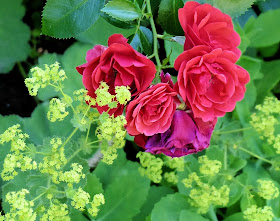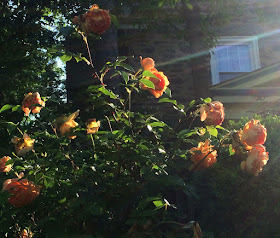 Was it the British nannies? The Child's Map of London on the wall by my bed? The British teachers, including the headmistress, at my school? Or maybe that my grandmother looking just like Queen Elizabeth I to my young eyes? For whatever reason, I developed an early fascination for Britanna and all her squiggly bits. Or, as I often put it at about age seven, "I should have been English. I was supposed to be English," as if I'd somehow gotten the wrong plane ticket, which merely needed to be exchanged.
Was it the British nannies? The Child's Map of London on the wall by my bed? The British teachers, including the headmistress, at my school? Or maybe that my grandmother looking just like Queen Elizabeth I to my young eyes? For whatever reason, I developed an early fascination for Britanna and all her squiggly bits. Or, as I often put it at about age seven, "I should have been English. I was supposed to be English," as if I'd somehow gotten the wrong plane ticket, which merely needed to be exchanged. Reality, in the form of a trip to England when I was 18, dispelled many of my more extreme delusions as to the allure of all things British, as did a later trip and later experiences, I now see and feel the rightness of my being American. I am happy to be a Yank rather than a Brit, a citizen rather than a subject . But there was no reasoning with my childhood self, who in her constant reading put down a firm, old-fashioned knowledge base about Albion, from which I can still draw on for irrelevant facts and other odd bits of useless information, some even pertaining to gardening.
Reality, in the form of a trip to England when I was 18, dispelled many of my more extreme delusions as to the allure of all things British, as did a later trip and later experiences, I now see and feel the rightness of my being American. I am happy to be a Yank rather than a Brit, a citizen rather than a subject . But there was no reasoning with my childhood self, who in her constant reading put down a firm, old-fashioned knowledge base about Albion, from which I can still draw on for irrelevant facts and other odd bits of useless information, some even pertaining to gardening.In the garden picture above, see that small yellow-flowering tree to the right of the President Lincoln Lilac? The yellow blossoming tree is a Laburnum, which is much more common in England than here. How do I know? Well, as soon as I became interested in gardening I used the PHS's library to read...every book on gardening I could find, and by some happen chance--most of them were about the United Kingdom. Which, of course, meant that as soon as I heard "Laburnum" my mind flashed onto this iconic view of a famous British garden image: Rosemary Verey's " Laburnum Walk" at Barnsley House.

Quite lovely, isn't it, and intensely romantic. My small garden could not contain such a display--but I can underplant my Laburnum with as many alliums as I can. A nice bit of inspiration a bit apart from the usual, which is one of the fun things about being an Anglophile/Anglophobe (one is rarely one without the other.) There is a whole nother world of influences to explore.
To the right stands my tiny clump of Snake's Head Fritilly, also called Chequered Lily, that blooms in my small rock garden. This is another plant not often seen in America but popular in England, and made very well-known by the late Christopher Lloyd at Great Dixter. Below is a picture of the meadow that his mother started planting with these babies. I forget in which book it is that he describes her assiduous efforts to enlarge her stock--but it obviously left an impression on her son, and on me.
So--on to more plants. Here on the left you can see the only Euphorbia I can't kill. I know because I have killed many. I love Euphorbias, partly for their yellow-green flowers, partly for the ecstatic euphony of their name. The one you see here in flower is an excellent groundcover for shade and semi-shade. When fresh its leaves are common leaf green, but as the summer heats they turn a very dark green. This makes them useful for contrast: we have them planted round a Japanese Maple with leaves of pale, mottled green. This variety pictured is Euphorbia amygdaloides var. robbiae, also called Mrs. Robb's bonnet. Mrs. Robb was English, gardened in Hampshire and traveled in Greece and Turkey, where she found this spurge and brought it home in a hat box. For that alone I would have it in my garden. Add on that it is resilient, beautiful and needs little water once established. Why it is not more used in America I have no idea.
My vision garden bliss is of a traditional Cottage garden abundantly overgrowing and cloaking its underlying formal structure. How English is that? Very, I would say. Have you ever visited the Cotswolds or the Home Counties? Plus, this love of England seems to seep through my whole neighborhood. Can you really tell that the next four pictures are of gardens near mine and not English ones?
Even though I use a large mix of low-care plants, some English, most native, the overall effect feels English. By which I mean that there is an ease about it all. It is a domestic, comfortable garden with (I hope) elegant touches that lack pretension. (I mean, I use bowling balls instead of gazing balls to form my quinquinux.) So I'm pretty sure that it is pretty obvious that my vision has many of its roots in ole Blighty. So maybe all my posts deal with the inherent Englishness of my Browne, Robertson, Jekyll, Sackwell-West, Lloyd, Fish, Verey, Hobhouse, Windsor, Chatto-influenced garden, even if I do not say it in every post. I'm saying it in this one.
On the right is Persicaria amplexicaulis ‘Firetail. This one blooms much later than its pink cousin and gets taller as well, a good three feet in sun. Like its cousin it spreads, but not too fast, so if you want to keep it in bounds just occasionally donate an edge of it to a local plant sale. Firetail's deep red holds up well in the hot, wilting sun of August and goes well with the ever-present Black-eyed Susans.
This last one is Persicaria affinis 'Dimity,' and it blooms from July on. Like its two cousins it needs little care or water, just some space and a good contrasting bloom. I use coneflower with it since they contrast harmoniously in color and shape.
Now, I'm not going to go overboard on detailing my roses and their origins. Suffice to say that some are Austin, and that they all are planted in a cottage, not a formal style.


Last of all is a fine plant that is sold by American nurseries, but that I have not seen in American gardens. It is Crambe cordifolia. I like it for its delicate baby breath-like flowers, its large Gunnera-like leaves and its name's silent, old fashioned b.
So, I will finish with a final soapbox thought. According to the Bible it is not good for humans to be alone. I think the same thing might be true of countries. And the United States tends to see itself as very much alone. The only thing that ever really mitigated that was WWII and the post-war "special relationship" with Great Britain. From that we got the idea of an English-Speaking Union and a consensus that helped produce kids like me.
 I feel as if the United Kingdom were a parent and America was its first-born son, rebellious and impatient. so he left in a huff after a fight. And the U.K., as parents often do, then got easier and less bossy with the other children, who were more able (though oldest daughters Ireland and India sure had a squabble,) to amicably break away. Hence the Commonwealth, that strange vestige of colonialism which makes for a very pluralistic, weirdly po-mo entity. Which the United States should still belong to. I mean, sometimes I think the Royals are more popular here than in their own country. We would get the symbolism and our siblings back. I'm not sure what the Commonwealth would get, but I hope that they would be charitable and take in a poor pseudo-orphan. The Anglo-Scot roots of our government, law and economy are clear. And the Commonwealth, which is amazingly diverse, might make our own diversity feel more at home.
I feel as if the United Kingdom were a parent and America was its first-born son, rebellious and impatient. so he left in a huff after a fight. And the U.K., as parents often do, then got easier and less bossy with the other children, who were more able (though oldest daughters Ireland and India sure had a squabble,) to amicably break away. Hence the Commonwealth, that strange vestige of colonialism which makes for a very pluralistic, weirdly po-mo entity. Which the United States should still belong to. I mean, sometimes I think the Royals are more popular here than in their own country. We would get the symbolism and our siblings back. I'm not sure what the Commonwealth would get, but I hope that they would be charitable and take in a poor pseudo-orphan. The Anglo-Scot roots of our government, law and economy are clear. And the Commonwealth, which is amazingly diverse, might make our own diversity feel more at home.So I guess I really haven't changed all that much after all. I still want to be English. I just want to be American first. Nothing wrong with have your cake and eat it too.

















Beautiful photos! :)
ReplyDelete